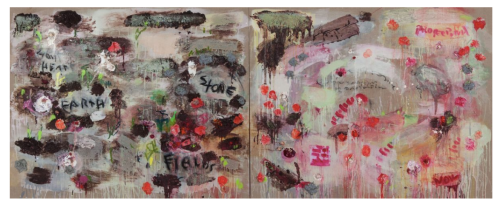
Blain|Southern is delighted to announce Rosebuds & Rivers, Joan Snyder’s (b. 1940, New Jersey, US) first solo exhibition in the UK. Comprising new and recent paintings, the exhibition will include a group of monumental triptychs and diptychs alongside smaller-scale works. It offers an insight into the experimentation and visual language for which Snyder is celebrated.
One of the pre-eminent artists of her generation, Joan Snyder made her breakthrough in the late 1960s with her ‘stroke’ paintings – a body of abstractions developed from her experiments regarding the anatomy of a painting. She painted paint strokes and other dissected parts – gestures, drips and marks – and laid them over pencilled grids, using the structures as a basis from which to compose narratives. ‘At the time my idea was to study the anatomy of a stroke, isolating them and using them much like creating a symphony or a piece of music’.
The desire to put in more, not less, to tell her stories led Snyder to break with the prevailing male-dominated abstract movements of Minimalism and Colour Field painting. She began to work from a loose grid to create mixed media paintings which she felt drew from a female sensibility: ‘… our experiences are different, our bodies are different, our lives are different and if we’re going to write or make art it’s going to be different.’ Finding a new way to ‘speak’ by using non-art materials and personal symbolism, Snyder has over the past five decades developed a distinctive visual vocabulary. ‘I speak with symbols and marks and colours and material.’
Building up surfaces with paint and organic matter, Snyder creates paintings that are narratives of both personal and shared experiences. In the largest work in the exhibition, Fragments of a Soul (2018), pieces of Joan Snyder, Proserpina, 2013, Courtesy the artist and Blain|Southern bark, herbs, glitter and scribbles on tiny pieces of paper form a saga of totem-like figures in a vast landscape. Chinese herbs and amber resin adorn the canvas of Floating Soul (2018); the artist describes adding scraps of paper with hidden notes as ‘almost performative’, it ‘became like the Wailing Wall for me, where I was making little notes and then pinning them on and just being caught up in that process.’
Snyder’s paintings have a profound relationship with music. Music is often part of her process and informs the structure of her paintings. During concerts, Snyder makes preparatory sketches which are annotated and revised repeatedly. These sketches can exist for several years before she commits to working on canvas. ‘There’s a lot of structure involved and a lot of thought and planning but when they happen it’s a little bit like jazz music – they really HAPPEN.’ Rose & Vine (2018) was conceived at a Philip Glass concert, where the repetition in Glass’ compositions inspired the artist to imagine how a painting of endless roses would appear.
The inspiration for Proserpina (2013) comes from a Kate McGarrigle song about a mother who loses her daughter for a third of the year to Hades in the underworld. Ceres, her mother, searches in vain, turning the fields into stone and threatening to destroy the earth in her desperation to get her daughter back. Proserpina uses scrawled words to moving effect, invoking ‘EARTH’ and ‘STONE’ and ‘HEAT’ 1 – Snyder writes on paintings when she feels she can’t communicate any other way.
Many of Snyder’s paintings originate from sketches, but not all. Yellow Figure (2018), is a work that happened spontaneously. Composed of three figures, the painting is part of a series of works, relating to a motherdaughter saga of her own. She says of this recent work ‘I really love being in my studio as intense and difficult as the subject matter might be. I trust my process, I go on automatic pilot and use a language I’ve built up over many years. It isn't a verbal language that can be easily described, it often is coming from the collective unconscious. You can’t always put it in words … there’s a kind of magic that happens.’